Macromolecules practice - Study guides, Class notes & Summaries
Looking for the best study guides, study notes and summaries about Macromolecules practice? On this page you'll find 204 study documents about Macromolecules practice.
Page 2 out of 204 results
Sort by
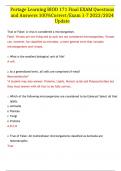
-
BIOD 171 Portage Learning Final EXAM Questions and Answers 100%Correct/Exam 1-7 2023/2024 Update
- Exam (elaborations) • 44 pages • 2023
-
- $20.99
- 5x sold
- + learn more
BIOD 171 Portage Learning Final EXAM Questions and Answers 100%Correct/Exam 1-7 2023/2024 UpdatePortage Learning BIOD 171 Final EXAM Questions and Answers 100%Correct/Exam 1-7 2023/2024 Update True or False: A virus is considered a microorganism. False. Viruses are not living and as such are not considered microorganisms. Viruses can, however, be classified as microbes, a more general term that includes microorganisms and viruses. 1. What is the smallest biological unit of life? A cell. ...
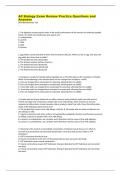
-
AP Biology Exam Review Practice Questions and Answers
- Exam (elaborations) • 42 pages • 2024
-
- $15.39
- + learn more
AP Biology Exam Review Practice Questions and Answers DNA/Biochemestry Test -- 1. The digestive enzyme pepsin works in the acidic environment of the stomach to hydrolyze peptide bonds. On which macromolecules does pepsin act? A. carbohydrate B. protein C. DNA D. lipid B. Protein 2. Egg whites consist primarily of water and the protein albumin. When you fry an egg, why does the egg white turn from clear to white? A. The protein becomes dissociated. B. The protein acquires terti...
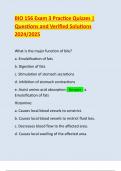
-
BIO 156 Exam 3 Practice Quizzes | Questions and Verified Solutions 2024/2025
- Exam (elaborations) • 43 pages • 2024
- Available in package deal
-
- $12.99
- + learn more
BIO 156 Exam 3 Practice Quizzes | Questions and Verified Solutions 2024/2025 What is the major function of bile? a. Emulsification of fats b. Digestion of fats c. Stimulation of stomach secretions d. Inhibition of stomach contractions e. Assist amino acid absorption - Answer - a. Emulsification of fats Histamine: a. Causes local blood vessels to constrict. b. Causes local blood vessels to restrict fluid loss. c. Decreases blood flow to the affected area. d. Causes local swelling of...
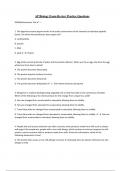
-
AP Biology Exam Review Practice Questions
- Exam (elaborations) • 67 pages • 2024
-
Available in package deal
-
- $9.49
- + learn more
AP Biology Exam Review Practice Questions DNA/Biochemestry Test ️-- 1. The digestive enzyme pepsin works in the acidic environment of the stomach to hydrolyze peptide bonds. On which macromolecules does pepsin act? A. carbohydrate B. protein C. DNA D. lipid ️B. Protein 2. Egg whites consist primarily of water and the protein albumin. When you fry an egg, why does the egg white turn from clear to white? A. The protein becomes dissociated. B. The protein acquires terti...
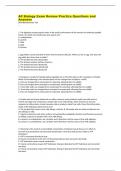
-
AP Biology Exam Review Practice Questions and Answers
- Exam (elaborations) • 42 pages • 2024
- Available in package deal
-
- $14.69
- + learn more
AP Biology Exam Review Practice Questions and Answers DNA/Biochemestry Test -- 1. The digestive enzyme pepsin works in the acidic environment of the stomach to hydrolyze peptide bonds. On which macromolecules does pepsin act? A. carbohydrate B. protein C. DNA D. lipid B. Protein 2. Egg whites consist primarily of water and the protein albumin. When you fry an egg, why does the egg white turn from clear to white? A. The protein becomes dissociated. B. The protein acquires terti...
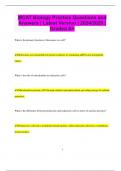
-
MCAT Biology Practice Questions and Answers | Latest Version | 2024/2025 | Graded A+
- Exam (elaborations) • 96 pages • 2024
-
Available in package deal
-
- $11.73
- + learn more
MCAT Biology Practice Questions and Answers | Latest Version | 2024/2025 | Graded A+ What is the primary function of ribosomes in a cell? Ribosomes are responsible for protein synthesis by translating mRNA into polypeptide chains. What is the role of mitochondria in eukaryotic cells? Mitochondria generate ATP through oxidative phosphorylation, providing energy for cellular processes. What is the difference between prokaryotic and eukaryotic cells in terms of nucleus presence...
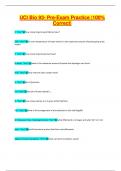
-
UCI Bio 93- Pre-Exam Practice |100% Correct
- Exam (elaborations) • 17 pages • 2024
- Available in package deal
-
- $9.49
- + learn more
UCI Bio 93- Pre-Exam Practice |100% Correct| 1 *Ans*how many rings do pyrimidines have? 15% *Ans*in room temperature of water what % is the maximum amount of bonds going to be made? 2 *Ans*how many rings do purines have? 4 bonds *Ans*what is the maximum amount of bonds that hydrogen can form? 4 VE *Ans*how many VE does carbon have? 5 *Ans*pH of lysosome 7.4 *Ans*the pH of human blood is... 9 *Ans*how many calories is in 1 gram of fat? (all fats) 9+2 *Ans*what is th...
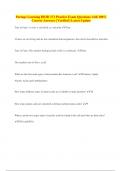
-
Portage Learning BIOD 171 Practice Exam Questions with 100% Correct Answers | Verified | Latest Update
- Exam (elaborations) • 5 pages • 2024
- Available in package deal
-
- $10.98
- + learn more
Portage Learning BIOD 171 Practice Exam Questions with 100% Correct Answers | Verified | Latest Update True or False: A virus is classified as a microbe True. Viruses are not living and are not considered microorganisms, but can be classified as microbes. True or False: The smallest biological unit of life is a molecule. False The smallest unit of life is a cell. What are the four main types of macromolecules found in a cell? Proteins, Lipids, Nucleic Acids and Carbohydrates How many dif...
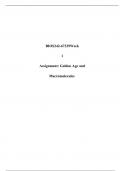
-
BIOS 242 Week 1 Assignment; Golden Age and Macromolecules
- Other • 8 pages • 2024
-
- $9.99
- + learn more
BIOS 242 Week 1 Assignment; Golden Age and Macromolecules Golden Age of Microbiology: Use the given active learning template (ALT) to connect Scientists with their discoveries in 1-2 sentences. (Slide 1; 2.5 points) Carolus Linnaeus: Known as the father of modern taxonomy, Linnaeus established a uniform system for naming organisms, a practice known as binomial nomenclature. Antoni van Leeuwenhoek: Often referred to as the father of microbiology, Leeuwenhoek was the first to observe and de...
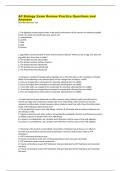
-
AP Biology Exam Review Practice Questions and Answers
- Exam (elaborations) • 42 pages • 2024
-
- $15.59
- + learn more
AP Biology Exam Review Practice Questions and Answers DNA/Biochemestry Test -- 1. The digestive enzyme pepsin works in the acidic environment of the stomach to hydrolyze peptide bonds. On which macromolecules does pepsin act? A. carbohydrate B. protein C. DNA D. lipid B. Protein 2. Egg whites consist primarily of water and the protein albumin. When you fry an egg, why does the egg white turn from clear to white? A. The protein becomes dissociated. B. The protein acquires terti...

Did you know that on average a seller on Stuvia earns $82 per month selling study resources? Hmm, hint, hint. Discover all about earning on Stuvia


